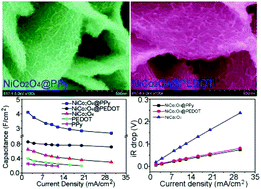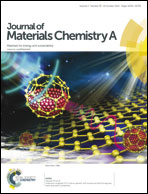Understanding the effect of polypyrrole and poly(3,4-ethylenedioxythiophene) on enhancing the supercapacitor performance of NiCo2O4 electrodes†
Abstract
Herein, two of the most well-known conducting polymers (CP), polypyrrole (PPy) and poly(3,4-ethylenedioxythiophene) (PEDOT), were coated onto mesoporous NiCo2O4 nanosheet arrays through an efficient and controllable electrodeposition process. We considered such a unique nanostructure to be an ideal model to accurately compare and understand the effects of PPy and PEDOT on electrochemical performances. Comparing the electrochemical performances of NiCo2O4@CP and pure NiCo2O4 electrodes, we found that the NiCo2O4@PPy electrode possesses the highest areal capacitance of 4.1 F cm−2 at 2 mA cm−2, which is significantly higher than the values obtained for the NiCo2O4@PEDOT (0.86 F cm−2) and NiCo2O4 electrodes (0.65 F cm−2). For rate capability, even at a high current density of 30 mA cm−2, an areal capacitance of 2.7 F cm−2 can be achieved for the NiCo2O4@PPy electrode. Moreover, the NiCo2O4@PPy electrode shows considerably smaller equivalent series resistance (ESR) than that of the NiCo2O4@PEDOT and NiCo2O4 electrodes. Therefore, the NiCo2O4@PPy hybrid composites are considered to be ideal supercapacitor electrode materials with enhanced electrochemical performances, which makes them suitable for many practical applications.


 Please wait while we load your content...
Please wait while we load your content...